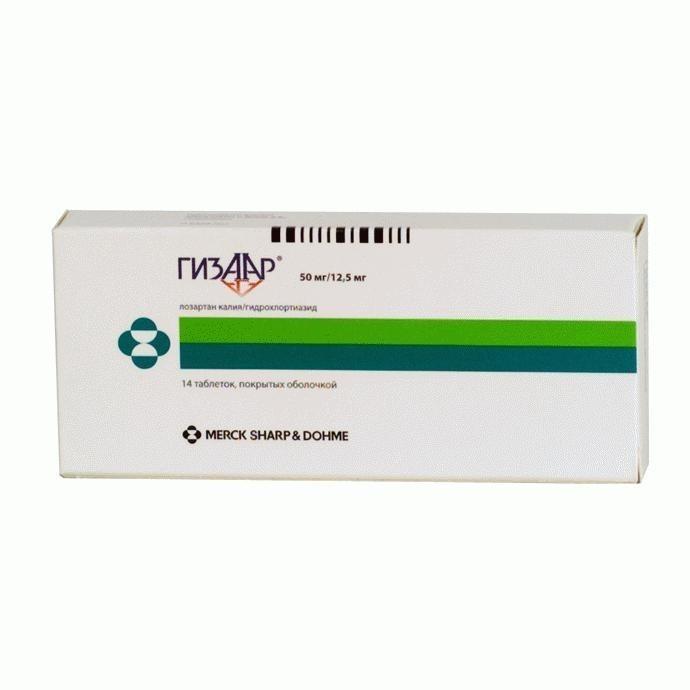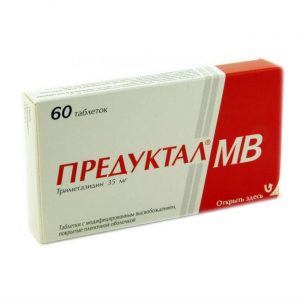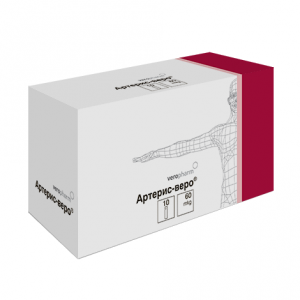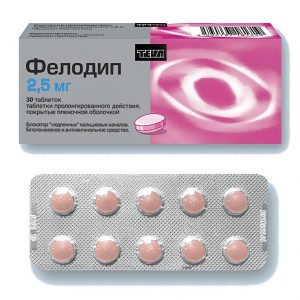Description
Latin name
HYZAAR
Release form
Coated tablets.
Packing
In a pack of 14 tablets.
Indications
Treatment of arterial hypertension in patients for whom the appointment of combination therapy is advisable.
To reduce the risk of cardiovascular morbidity and mortality in patients with arterial hypertension and left ventricular hypertrophy.
Contraindications
anuria.
Severe renal impairment (creatinine clearance (CC) less than 30 ml / min).
Severe impaired liver function.
Hypersensitivity to any component of the drug.
Hypersensitivity to other sulfonamide-derived drugs.
Caution is advised when using the drug for:
Impaired water-electrolyte balance (dehydration, hyponatremia, hypochloremic alkalosis, hypomagnesemia, hypokalemia), which can develop against the background of intercurrent diarrhea or vomiting.
Bilateral renal artery stenosis or single kidney artery stenosis.
Diabetes.
In patients with hypercalcemia, hyperuricemia and / or gout.
In patients with a burdened allergic history and bronchial asthma.
For systemic diseases of the connective tissue (including SLE).
Hypovolemia (including against the background of high doses of diuretics.
Concomitant use with NSAIDs (including including with COX-2 inhibitors).
Use during pregnancy and lactation
The use of drugs that have a direct effect on the renin-angiotensin system in the second and third trimesters of pregnancy can have a teratogenic effect and cause fetal death. Immediately after pregnancy is established, Gizaar should be discontinued.
Adequate and strictly controlled clinical studies of the safety of Gizaar during pregnancy have not been conducted.
In experimental animal studies, it was shown that the use of losartan can have a teratogenic effect and cause death of the fetus and newborn, which is likely due to the effect of this active substance on the renin-angiotensin system.
In a human fetus, kidney perfusion, which depends on the development of the renin-angiotensin system, begins in the II trimester, thus, the risk of impaired development and death of the fetus increases with the use of Gizaar in the II or III trimesters of pregnancy.
Thiazides cross the placental barrier and are detected in cord blood. The routine use of diuretics in pregnant women without concomitant diseases is not recommended, becausepleasant reactions that are observed in adults. Diuretics do not prevent the development of toxicosis of pregnancy, while there is no convincing evidence that they have a positive effect on the course of toxicosis.
There is no evidence that losartan is excreted in breast milk. However, it is known that thiazides are excreted in breast milk. If it is necessary to use the drug during lactation, the expected benefit of therapy for the mother and the existing risk of side effects in the infant should be assessed.
Ingredients
Active ingredients:
Potassium losartan 50 mg
Hydrochlorothiazide 12.5 mg
Excipients:
Microcrystalline cellulose
Lactose aqueous
Starch starch.
Shell composition:
Hydroxypropyl methylcellulose
Hydroxypropyl cellulose
Titanium dioxide
Quinoline aluminum lacquer yellow
Carnauba wax.
Dosage and administration
Gizaar can be prescribed in combination with other antihypertensive agents. Gizaar can be taken without regard to meals.
For arterial hypertension: The usual initial and maintenance dose of the drug is 1 tab. Gizaara 1 time / day. In the absence of an adequate therapeutic effect within 2-4 weeks, the dose should be increased to 2 tablets. Gizaara 50 / 12.5 mg 1 time / day. The maximum dose is 2 tablets. Gizaara 50 / 12.5mg 1 time / day. As a rule, the antihypertensive effect is achieved within 3 weeks after the start of therapy. The selection of the initial dose of Gizaar for elderly patients is not required.
In order to reduce the risk of cardiovascular morbidity and mortality in patients with arterial hypertension and left ventricular hypertrophy: The drug is prescribed in a standard initial dose of losartan, which is 50 mg 1 time / day. Patients who cannot achieve their blood pressure targets with losartan 50 mg / day treatment is required by combining losartan with low doses of hydrochlorothiazide (12.5 mg), and, if necessary, increase the dose of losartan to 100 mg in combination with hydrochlorothiazide at a dose of 12.5 mg / day, then increase the dose to 2 tab. Gizaara 50 mg / 12.5 mg (total 100 mg of losartan and 25 mg of hydrochlorothiazide per day once).
Side effects of
In clinical trials with losartan / hydrochlorothiazide, no adverse events specific to this combination drug were observed.
Adverse reactions were limited to those already reported with losartan and / or hydrochlorothiazide alone. Total frequency of adverse reactions, reported when using this combination was comparable to placebo. The frequency of discontinuation of therapy was also comparable to that of patients receiving placebo. In most cases, adverse reactions were mild, transient, and did not require discontinuation of therapy.
In controlled clinical trials, dizziness was the only drug-related adverse reaction whose frequency exceeded that of a placebo by more than 1 percent or more.
Losartan in combination with hydrochlorothiazide is generally well tolerated in patients with arterial hypertension and left ventricular hypertrophy. The most common adverse reactions were dizziness, weakness, and fatigue.
In the course of the post-marketing experience of using the drug, the following additional adverse reactions were reported: Allergic reactions and immunopathological reactions: anaphylactic reactions, angioedema, including swelling of the larynx and glottis with the development of obstruction of the airways and / or swelling of the face, lips, pharynx and / or tongue, in patients taking losartan some of these patients had indications of a history of angioedema when using other drugs, i.e. h ACE inhibitors. There are rare reports of the development of vasculitis (including Shenlein-Genoch purpura) with losartan.
From the digestive system: rarely – hepatitis, diarrhea (in patients taking losartan).
From the respiratory system: cough is possible (in patients taking losartan).
Dermatological reactions: urticaria, increased light and photosensitivity.
On the part of laboratory parameters: in controlled clinical trials while taking Gizaar®, clinically significant changes in standard laboratory parameters were rarely observed. Hyperkalemia (serum potassium of more than 5.5 meq / l) was observed in 0.7% of patients, which did not require discontinuation of the drug. An increase in ALT activity was rare and usually disappeared after discontinuation of therapy.
Drug Interaction
Losartan
In clinical pharmacokinetic studies, no clinically relevant interaction of losartan with hydrochlorothiazide, digoxin, warfarin, cimetidine, phenobarbital, ketocarbonital, ketocarcinol was found.
Reportedly, rifampicin and fluconazole reduce the level of the active metabolite. The clinical significance of this interaction has not been studied.
Combination of losartan, like other angiotensin II blocking agents or its effects, with potassium-sparing diuretics (e.g. spironolactone, triamterene, amiloride), potassium-containing additives or potassium salts can lead to increased serum potassium levels.
NSAIDs (including selective COX-2 inhibitors) may reduce the effect of diuretics and other antihypertensive drugs. Therefore, the hypotensive effect of angiotensin II receptor antagonists may be attenuated when co-administered with NSAIDs (including COX-2 inhibitors). In some patients with impaired renal function receiving NSAIDs (including COX-2 inhibitors), treatment with angiotensin II receptor antagonists may cause further impairment of renal function, including acute renal failure, which is usually reversible.
The antihypertensive effect of losartan, like other antihypertensive agents, may be attenuated when indomethacin is taken.
Hydrochlorothiazide
With the simultaneous use of thiazide diuretics with barbiturates, opioid analgesics, ethanol may increase the risk of orthostatic arterial hypotension.
Hypoglycemic dose adjustments (for oral and insulin administration) may be required when used concomitantly. When using hydrochlorothiazide with other antihypertensive agents, an additive effect is observed.
In the presence of anion exchange resins, the absorption of hydrochlorothiazide is impaired.
Cholestyramine or colestipol in single doses bind hydrochlorothiazide and reduce its gastrointestinal absorption by 85% and 43%, respectively.
The use of corticosteroids, ACTH leads to a marked decrease in the level of electrolytes, in particular, can cause hypokalemia.
It is possible to reduce the severity of the response to the administration of pressor amines (eg, epinephrine). It is possible to increase the effect of muscle relaxants of a non-depolarizing type of action (eg, tubocurarin).
Diuretics reduce the renal clearance of lithium and increase the risk of its toxic effects The combined use of diuretics and lithium preparations is not recommended.
In some cases, taking NSAIDs (including selective COX-2 inhibitors) may reduce the diuretic, natriuretic and antihypertensive effects of diuretics. Due to the effect of thiazides on calcium metabolism, their intake may distort the results of the study of the function of the parathyroid glands.
overdose There is no specific data on the specific treatment for Gizaar overdose. The drug should be discontinued and the patient should be monitored. Symptomatic therapy is shown – induction of vomiting in case the drug is taken recently, as well as elimination of dehydration, electrolyte disorders, hepatic coma and reduction of blood pressure by standard methods.
There are limited data on the overdose of losartan in humans. The most likely symptoms of overdose are a marked decrease in blood pressure and tachycardia bradycardia may be due to parasympathetic (vagal) stimulation.
Treatment: Supportive therapy is indicated in the case of symptomatic arterial hypotension. Losartan and its active metabolite are not eliminated by hemodialysis.
The most common symptoms of hydrochlorothiazide overdose are due to electrolyte deficiency (hypokalemia, hypochloremia, hyponatremia) and dehydration due to excessive diuresis. With concomitant administration of cardiac glycosides, hypokalemia may aggravate the course of arrhythmias. It has not been established to what extent hydrochlorothiazide can be removed from the body by hemodialysis.
Expiration
3 years.
Active ingredient
Hydrochlorothiazide, Losartan
pharmacies
pharmacy terms for
dosage form
drug vein form
tablets
Merk Sharp and Doom BV, USA p19rorew463715 Doom BV, USA




